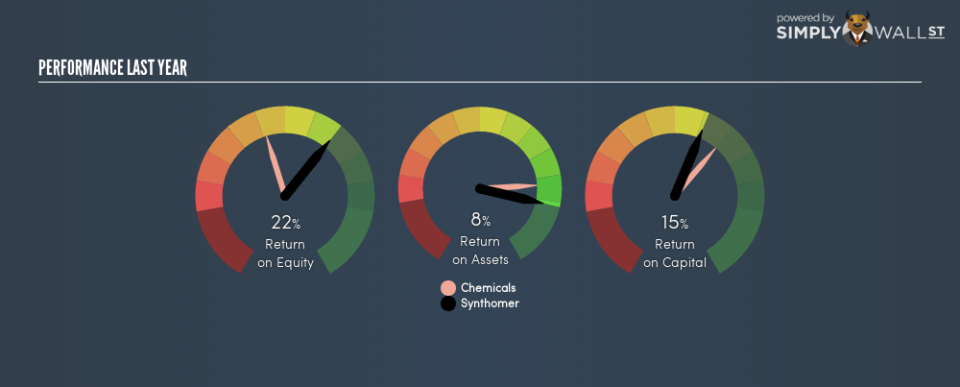Is Synthomer plc (LON:SYNT) Struggling With Its 15% Return On Capital Employed?

Today we are going to look at Synthomer plc (LON:SYNT) to see whether it might be an attractive investment prospect. Specifically, we’ll consider its Return On Capital Employed (ROCE), since that will give us an insight into how efficiently the business can generate profits from the capital it requires.
First up, we’ll look at what ROCE is and how we calculate it. Second, we’ll look at its ROCE compared to similar companies. And finally, we’ll look at how its current liabilities are impacting its ROCE.
What is Return On Capital Employed (ROCE)?
ROCE measures the ‘return’ (pre-tax profit) a company generates from capital employed in its business. All else being equal, a better business will have a higher ROCE. Ultimately, it is a useful but imperfect metric. Author Edwin Whiting says to be careful when comparing the ROCE of different businesses, since ‘No two businesses are exactly alike.’
So, How Do We Calculate ROCE?
Analysts use this formula to calculate return on capital employed:
Return on Capital Employed = Earnings Before Interest and Tax (EBIT) ÷ (Total Assets – Current Liabilities)
Or for Synthomer:
0.15 = UK£134m ÷ (UK£1.3b – UK£362m) (Based on the trailing twelve months to June 2018.)
Therefore, Synthomer has an ROCE of 15%.
Check out our latest analysis for Synthomer
Want to help shape the future of investing tools and platforms? Take the survey and be part of one of the most advanced studies of stock market investors to date.
Does Synthomer Have A Good ROCE?
When making comparisons between similar businesses, investors may find ROCE useful. Using our data, Synthomer’s ROCE appears to be around the 13% average of the Chemicals industry. Independently of how Synthomer compares to its industry, its ROCE in absolute terms appears decent, and the company may be worthy of closer investigation.
It is important to remember that ROCE shows past performance, and is not necessarily predictive. Companies in cyclical industries can be difficult to understand using ROCE, as returns typically look high during boom times, and low during busts. This is because ROCE only looks at one year, instead of considering returns across a whole cycle. What happens in the future is pretty important for investors, so we have prepared a free report on analyst forecasts for Synthomer.
Do Synthomer’s Current Liabilities Skew Its ROCE?
Current liabilities include invoices, such as supplier payments, short-term debt, or a tax bill, that need to be paid within 12 months. Due to the way ROCE is calculated, a high level of current liabilities makes a company look as though it has less capital employed, and thus can (sometimes unfairly) boost the ROCE. To counter this, investors can check if a company has high current liabilities relative to total assets.
Synthomer has total assets of UK£1.3b and current liabilities of UK£362m. As a result, its current liabilities are equal to approximately 28% of its total assets. Current liabilities are minimal, limiting the impact on ROCE.
What We Can Learn From Synthomer’s ROCE
With that in mind, Synthomer’s ROCE appears pretty good. Of course you might be able to find a better stock than Synthomer. So you may wish to see this free collection of other companies that have grown earnings strongly.
If you like to buy stocks alongside management, then you might just love this free list of companies. (Hint: insiders have been buying them).
To help readers see past the short term volatility of the financial market, we aim to bring you a long-term focused research analysis purely driven by fundamental data. Note that our analysis does not factor in the latest price-sensitive company announcements.
The author is an independent contributor and at the time of publication had no position in the stocks mentioned. For errors that warrant correction please contact the editor at editorial-team@simplywallst.com.

